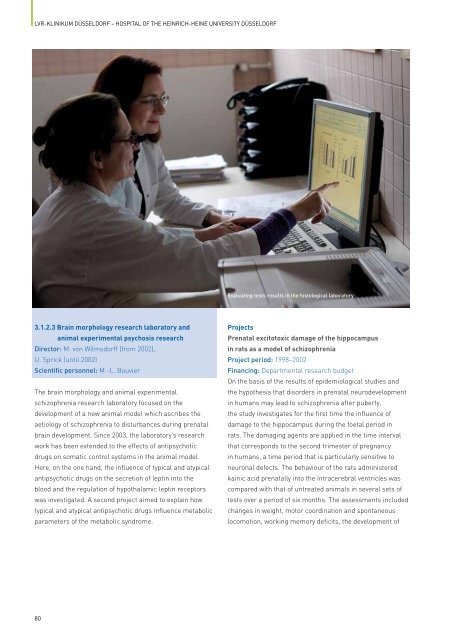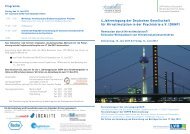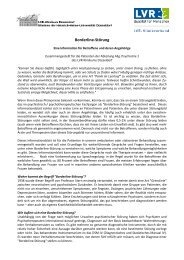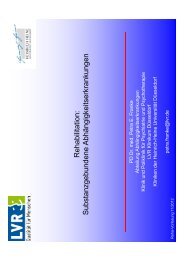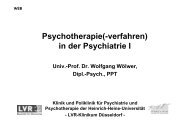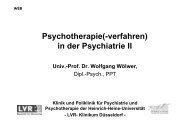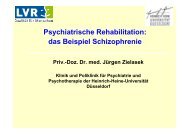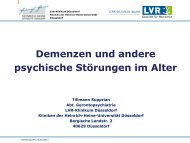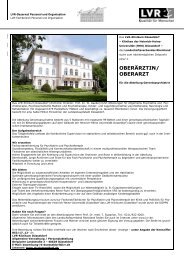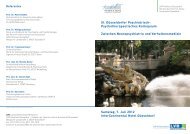LVR-Klinikum Düsseldorf Hospital of the Heinrich-Heine University ...
LVR-Klinikum Düsseldorf Hospital of the Heinrich-Heine University ...
LVR-Klinikum Düsseldorf Hospital of the Heinrich-Heine University ...
You also want an ePaper? Increase the reach of your titles
YUMPU automatically turns print PDFs into web optimized ePapers that Google loves.
<strong>LVR</strong>-KLINIKUM DÜsseLDORF – hOsPITaL OF The heINRIch-heINe UNIVeRsITY DÜsseLDORF<br />
3.1.2.3 Brain morphology research laboratory and<br />
animal experimental psychosis research<br />
Director: M. von Wilmsdorff (from 2002),<br />
U. Sprick (until 2002)<br />
Scientific personnel: M.-L. Bouvier<br />
The brain morphology and animal experimental<br />
schizophrenia research laboratory focused on <strong>the</strong><br />
development <strong>of</strong> a new animal model which ascribes <strong>the</strong><br />
aetiology <strong>of</strong> schizophrenia to disturbances during prenatal<br />
brain development. Since 2003, <strong>the</strong> laboratory’s research<br />
work has been extended to <strong>the</strong> effects <strong>of</strong> antipsychotic<br />
drugs on somatic control systems in <strong>the</strong> animal model.<br />
Here, on <strong>the</strong> one hand, <strong>the</strong> influence <strong>of</strong> typical and atypical<br />
antipsychotic drugs on <strong>the</strong> secretion <strong>of</strong> leptin into <strong>the</strong><br />
blood and <strong>the</strong> regulation <strong>of</strong> hypothalamic leptin receptors<br />
was investigated. A second project aimed to explain how<br />
typical and atypical antipsychotic drugs influence metabolic<br />
parameters <strong>of</strong> <strong>the</strong> metabolic syndrome.<br />
80<br />
Evaluating tests results in <strong>the</strong> histological laboratory<br />
Projects<br />
Prenatal excitotoxic damage <strong>of</strong> <strong>the</strong> hippocampus<br />
in rats as a model <strong>of</strong> schizophrenia<br />
Project period: 1998–2002<br />
Financing: Departmental research budget<br />
On <strong>the</strong> basis <strong>of</strong> <strong>the</strong> results <strong>of</strong> epidemiological studies and<br />
<strong>the</strong> hypo<strong>the</strong>sis that disorders in prenatal neurodevelopment<br />
in humans may lead to schizophrenia after puberty,<br />
<strong>the</strong> study investigates for <strong>the</strong> first time <strong>the</strong> influence <strong>of</strong><br />
damage to <strong>the</strong> hippocampus during <strong>the</strong> foetal period in<br />
rats. The damaging agents are applied in <strong>the</strong> time interval<br />
that corresponds to <strong>the</strong> second trimester <strong>of</strong> pregnancy<br />
in humans, a time period that is particularly sensitive to<br />
neuronal defects. The behaviour <strong>of</strong> <strong>the</strong> rats administered<br />
kainic acid prenatally into <strong>the</strong> intracerebral ventricles was<br />
compared with that <strong>of</strong> untreated animals in several sets <strong>of</strong><br />
tests over a period <strong>of</strong> six months. The assessments included<br />
changes in weight, motor coordination and spontaneous<br />
locomotion, working memory deficits, <strong>the</strong> development <strong>of</strong>


